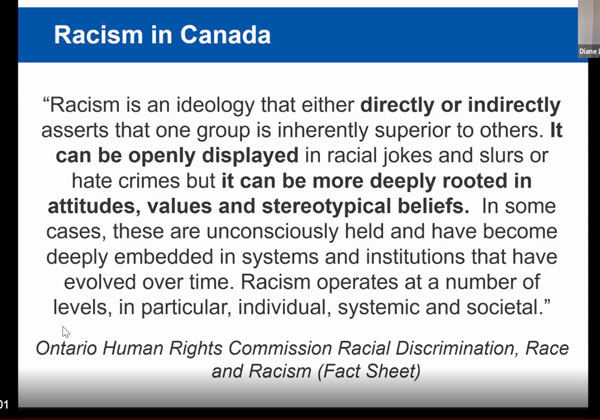Construction employers have legal obligations under two different pieces of legislation to provide workplaces that are free from racism, Ontario lawyer Diane Laranja told a recent webinar audience.
In fact, Laranja said during the anti-racism presentation hosted by the Residential Construction Council of Ontario (RESCON), recent anti-Black racism incidents on Toronto-area jobsites may have raised an obligation for employers to review their policies right now.
The webinar was held as part of RESCON’s launch of its Construction Against Racism Everywhere campaign.
“I’ll be frank, when a noose is found on a construction site, everyone is pointing fingers and immediately the question becomes, we need to have this discussion, we need to tackle this issue, we need to have more training,” said Laranja, counsel with Filion Wakely Thorup Angeletti LLP. “That starts with an anti-discrimination policy and that starts with anti-discrimination training, because ultimately who is responsible for the culture and the environment that is in our workplaces, it’s us, it’s the employer.”
Recent events have demonstrated that racism continues in Ontario and also presents itself, unfortunately, said Laranja, in the construction industry.
“Racism and particularly anti-Black racism is a difficult but long overdue conversation,” she said. “Many employers are asking these two questions: what should I being doing, and what am I required to do with regards to racism in the workplace?”
A survey conducted last year found that visible minorities constitute 11 per cent of Ontario’s unionized construction sector and 17 per cent of the non-unionized sector.
Another survey found that of workers who reported facing racism, 38 per cent experienced it in the workplace.

Obligations to protect workers from racism arise under the Ontario Human Rights Code and the Occupational Health and Safety Act (OHSA), Laranja explained.
The code applies to every workplace in Ontario.
“Employers have an obligation to ensure that employees do not experience discrimination on what are described as ‘protected grounds,’ ” Laranja noted.
The list is expansive, with 17 different protected grounds including race, colour, ancestry, place of origin, ethnic origin and citizenship.
The code imposes four key obligations on employers, three of which are of direct relevance to racism, said the lawyer: refraining from discriminatory practices; providing a working environment free from discrimination or harassment; and the obligation to not retaliate against someone who exercises their rights under the code.
“The code imposes liability for employers for the discriminatory actions of their employees, and that is key,” said Laranja. “It is not enough to say, ‘I didn’t discriminate against this individual, I didn’t create this environment, it is their colleagues or their co-workers.’ We as an employer are responsible for the environment that we are establishing and maintaining.”
Harassment can include making racial slurs or “jokes,” posting cartoons or pictures in a workplace that degrade a particular racial group, or creating nicknames based on race or colour.
The case of George vs. 1735475 Ontario Ltd. helped clarify the law relating to creating a poisoned environment, Laranja explained.
George was a Black Canadian and his employer and supervisor was of East Asian descent who on several occasions used the n-word. He would also engage in discussions in which he called Blacks who attend anti-racism rallies “stupid” and would refer to George in a negative context as “you people.”
The employer’s defence included the contention that racial slurs are common in the construction industry, and that he told his employees they should let racist comments slide off their backs.
The tribunal found that the applicant’s allegations were substantiated and awarded $20,000 in damages to George for injuries to his dignity, feelings and self-respect.
“This is becoming less and less of a belief but to the extent that it still exists, a pervasive culture of racism or the use of racial slurs on construction sites will not allow an employer to perpetuate racist attitudes in the workplace,” Laranja said.
Under the OHSA, employers have an obligation to create an environment free from workplace violence and harassment. The employer is specifically required to prepare policies and procedures with respect to violence and harassment.
Those policies have to be reviewed at least once a year to ensure they remain relevant — but changing circumstances should trigger an early review.
“I’ve got to tell you, what we are seeing recently happening on construction sites is a change in circumstances that should be compelling us to go back to our workplace violence policies and see if we need to update our risk assessment and determine if there is a risk of a racial incident on our sites. If there is, what steps we should be taking to address that,” said Laranja.
Follow the author on Twitter @DonWall_DCN.











Recent Comments
comments for this post are closed